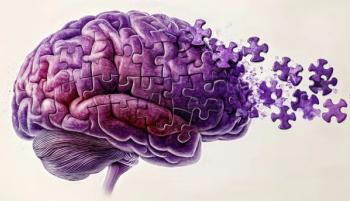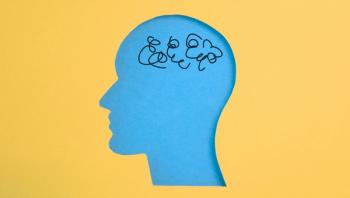
Pain and Dementia
How do you determine whether pain is present and its severity as well as how it responds to treatment in patients who are cognitively impaired? Some answers to these questions.
PAIN MANAGEMENT
Psychosomatics
Pain is a subjective complaint for which health care professionals largely depend upon self-report by patients. However, we face a special challenge in determining whether pain is present, its severity if it is, and how it is responding to treatment in patients who are cognitively impaired. A recent review of the problem of pain among patients who suffer
Epidemiology
Dementia largely occurs among older patients who, while not inevitably experiencing
Although there has long been a widely propagated myth that as people age they are less likely to experience pain, there is little to support this view. Studies have indicated that as many as 60% to 80% of residents of nursing homes with dementia and over 50% of those in the community with it experience pain.
Determining if pain is present
The greatest challenge to health care providers is determining whether patients with dementia are experiencing pain. Although patients with mild to moderate dementia may still be able to respond appropriately when asked if they are experiencing pain, those with more severe dementia are probably unable to gauge how much pain they feel, so asking them this question is unlikely to provide much information nor will the commonly used instruments to measure pain such as numerical rating scales.
Thus, it falls on healthcare providers to find alternative methods for identifying pain in those who can’t respond. Determining whether pain is present primarily consists of observing patients. Of greatest use in determining pain in patients who can’t self-report are observations of:
• Facial responses
• Vocalization
• Body movement or body posture
Although there have been multiple instruments (the review identified 19) that have incorporated these observable behaviors, the review considered them to be of poor or unproven reliability, to lack evidence of validity, and none had been tested for sensitivity to change. Thus, it is impossible to determine which one of these scales is be more reliable or valid than the others.
It is worth noting that two observational measures that may be useful for cognitively intact patients-improvement in levels of functioning and reduction in the use of analgesic medications-may be of limited use for patients with dementia whose functioning is already significantly limited by the cognitive impairment and who have little control of what medications they take and when they take them.
Treatment challenges
Even when pain is identified in patients with dementia, there are still multiple challenges with regard to treatment. Although analgesic medications may be beneficial, as with all geriatric patients, cormorbid conditions and reduced renal and hepatic function can make it difficult to find the optimal balance between pain relief while avoiding adverse effects. Furthermore, because of limitations in self report patients with dementia and pain may be unable to report those adverse effects when they do occur.
Pharmacologic management of pain
Recommendations with regard to pharmacologic management of pain among those with dementia follow. It should be noted, however, that these recommendations are based primarily on those for geriatric patients in general as there is little research on their efficacy specifically for patients with dementia:
1. Acetaminophen is considered the first-line medication although there is limited research beyond 3 months of use (ie, that would be considered being used for chronic pain)
2. Because of their potential adverse effects the use of
3. Opioids may be effective in managing pain although it is still an open question whether their benefits outweigh their potential adverse effects. One issue that the review doesn’t address is how much whatever benefits ascribed to opioids for patients with dementia may be due to their sedating effects. Considering that measurement of their efficacy would be primarily based on observation of the patients, sedation might be confused with patients actually experiencing a reduction in pain.
4. Other medications commonly used for the management of chronic pain, most notably the
5. Another issue not mentioned by the review is that of scheduling of medications. For patients in nursing homes, analgesic medications are often prescribed on a prn basis which means that patients with dementia who are unable to report they are having pain are unlikely to receive them. During my career, I have often observed that cognitively impaired patients who are prescribed prn sedative medications for agitation and prn medications for pain will receive the former because agitation is easily observable but won’t receive the latter because pain is not.
Nonpharmacologic interventions
As with the treatment of chronic pain for patients of any age, nonpharmacologic treatments should be considered and may be effective. They have the added benefits of essentially being free of adverse effects so therefore, unlike medications, are unlikely to exacerbate any other medical problems. However, as with pharmacologic therapies, there is limited research on these treatments for this patient cohort and the recommendations are primarily based on those for geriatric patients without dementia.
The most promising nonpharmacologic treatments for these patients are: exercise and/or movement therapies, massage and/or human touch, heat and relaxation therapies, human interaction and presence. Unfortunately, other interventions that may be effective for the management of chronic pain in cognitively intact patients, most notably psychologically based therapies such as cognitive-behavioral therapies, are of markedly limited use for patients with dementia. Other therapies that do not require direct involvement of the patient such as music therapy may be more effective.
Many of the treatments for chronic pain provided by physical and occupational therapists are focused on educating patients by teaching them alternative methods to manage their pain and how to perform tasks using different body mechanics. Obviously, learning new material would be difficult for many patients with dementia.
Conclusions
Health care providers must rely on observation of patients with dementia to determine if they are experiencing pain. Agitation on the part of these patients may be a reflection of pain. Health care providers should be especially observant for indications of pain among patients who are suffering from disorders that frequently cause pain such as rheumatologic disorders, Parkinson disease, diabetes.
Therapies to manage the pain must always be weigh potential benefits against potential adverse effects. Even though we have known about the difficulties of managing pain in patients with dementia for almost 30 years, we still have made relatively little progress on how best to evaluate their pain and how to treat it.2
Disclosures:
Dr King is in private practice in Philadelphia.
References:
1. Achterberg W, Lautenbacher S, Husebo B, et al.
2. Sengstaken EA, King SA.
Newsletter
Receive trusted psychiatric news, expert analysis, and clinical insights — subscribe today to support your practice and your patients.

















